Multicriteria Optimization
�
Matthias Ehrgott
Multicriteria
Optimization
Second edition
With 88 Figures and 12 Tables
1 2
�
Dr. habil. Matthias Ehrgott, Associate Professor
The University of Auckland
Department of Engineering Science
School of Engineering
Private Bag 92019
70 Symonds Street Level 3
Auckland 1001
New Zealand
m.ehrgott@auckland.ac.nz
Originally published as volume 491 in the series:
Lecture Notes in Economics and Mathematical Systems
Cataloging-in-Publication Data
Library of Congress Control Number: 2005924730
ISBN 3-540-21398-8 Springer Berlin Heidelberg New York
Bibliographic information published by Die Deutsche Bibliothek.
Die Deutsche Bibliothek lists this publication in the Deutsche Nationalbibliografie;
detailed bibliographic dat is available in the Internet at http://dnb.ddb.de
This work is subject to copyright. All rights are reserved, whether the whole or part of
the material is concerned, specifically the rights of translation, reprinting, reuse of illus-
trations, recitation, broadcasting, reproduction on microfilm or in any other way, and
storage in data banks. Duplication of this publication or parts thereof is permitted only
under the provisions of the German Copyright Law of September 9, 1965, in its current
version, and permission for use must always be obtained from Springer-Verlag. Violations
are liable for prosecution under the German Copyright Law.
Springer is a part of Springer Science+Business Media
springeronline.com
° Springer Berlin ´ Heidelberg 2005
Printed in Germany
The use of general descriptive names, registered names, trademarks, etc. in this publica-
tion does not imply, even in the absence of a specific statement, that such names are
exempt from the relevant protective laws and regulations and therefore free for general
use.
Hardcover-Design: Erich Kirchner, Heidelberg
SPIN 10996973
42/3153-5 4 3 2 1 0 ± Printed on acid-free paper
�
Preface
Life is about decisions. Decisions, no matter if made by a group or an individ-
ual, usually involve several conflicting objectives. The observation that real
world problems have to be solved optimally according to criteria, which pro-
hibit an “ideal” solution – optimal for each decision-maker under each of the
criteria considered – has led to the development of multicriteria optimization.
From its first roots, which where laid by Pareto at the end of the 19th cen-
tury the discipline has prospered and grown, especially during the last three
decades. Today, many decision support systems incorporate methods to deal
with conflicting objectives. The foundation for such systems is a mathematical
theory of optimization under multiple objectives.
Fully aware of the fact that there have been excellent textbooks on the
topic before, I do not claim that this is a better text, but it has a consider-
ably different focus. Some of the available books develop the mathematical
background in great depth, such as Sawaragi et al. (1985); G¨opfert and Nehse
(1990); Jahn (1986). Others focus on a specific structure of the problems cov-
ered as Zeleny (1974); Steuer (1985); Miettinen (1999) or on methodology Yu
(1985); Chankong and Haimes (1983); Hwang and Masud (1979). Finally there
is the area of multicriteria decision aiding Roy (1996); Vincke (1992); Keeney
and Raiffa (1993), the main goal of which is to help decision makers find the
final solution (among many “optimal” ones) eventually to be implemented.
With this book, which is based on lectures I taught from winter semester
1998/99 to winter semester 1999/2000 at the University of Kaiserslautern, I
intend to give an introduction to and overview of this fascinating field of math-
ematics. I tried to present theoretical questions such as existence of solutions
as well as methodological issues and hope the reader finds the balance not too
heavily on one side. The text is accompanied by exercises, which hopefully
help to deepen students’ understanding of the topic.
�
vi
Preface
The decision to design these courses as an introduction to multicriteria
optimization lead to certain decisions concerning the contents and material
contained. The text covers optimization of real valued functions only. And
even with this restriction interesting topics such as duality or stability have
been excluded. However, other material, which has not been covered in earlier
textbooks has found its way into the text. Most of this material is based on
research of the last 15 years, that is after the publication of most of the books
mentioned above. This applies to the whole of Chapters 6 and 7, and some of
the material in earlier chapters.
As the book is based on my own lectures, it is well suitable for a mathe-
matically oriented course on multicriteria optimization. The material can be
covered in the order in which it is presented, which follows the structure of
my own courses. But it is equally possible to start with Chapter 1, the basic
results of Chapters 2 and 3, and emphasize the multicriteria linear program-
ming part. Another possibility might be to pick out Chapters 1, 6, and 7 for a
course on multicriteria combinatorial optimization. The exercises at the end
of each Chapter provide possibilities to practice as well as some outlooks to
more general settings, when appropriate.
Even as an introductory text I assume that the reader is somehow famil-
iar with results from some other fields of optimization. The required back-
ground on these can be found in Bazaraa et al. (1990); Dantzig (1998) for
linear programming, Mangasarian (1969); Bazaraa et al. (1993) for nonlinear
programming, Hiriart-Uruty and Lemar´echal (1993); Rockafellar (1970) for
convex analysis, Nemhauser and Wolsey (1999); Papadimitriou and Steiglitz
(1982) for combinatorial optimization. Some results from these fields will be
used throughout the text, most from the sources just mentioned. These are
generally stated without proof. Accepting these theorems as they are, the text
is self-contained.
I am indebted to the many researchers in the field, on whose work the
lectures and and this text are based. Also, I would like to thank the students
who followed my class, they contributed with their questions and comments,
and my colleagues at the University of Kaiserslautern and elsewhere for their
cooperation and support. Special thanks go to Horst W. Hamacher, Kathrin
Klamroth, Stefan Nickel, Anita Sch¨obel, and Margaret M. Wiecek. Last but
not least my gratitude goes to Stefan Zimmermann, whose diligence and apti-
tude in preparing the manuscript was enormous. Without him the book would
not have come into existence by now.
�
Preface
vii
Preface to the Second Edition
Much has happened in multicriteria optimization since the publication of the
first edition of this book. Too much in fact for all the contributions in the
field to be reflected in this new edition, which – after all – is intended to
be a textbook for a course on multicriteria optimization. Areas which have
seen particularly strong growth are multiobjective combinatorial optimization
and heuristics for multicriteria optimization problems. I have tried to give
an indication of these new developments by adding “Notes” sections to all
chapters but one. These sections contain many references to the literature
for the interested reader. As a consequence the bibliography has more than
doubled compared to the first edition. Still, heuristics feature only in the very
last section and metaheuristics are not even mentioned.
There are a number of other changes to the organization of the book.
Linear and combinatorial multicriteria optimization is now spread over five
chapters, which seems appropriate for material that covers roughly half the
pages. It also reflects the way in which I have usually taught multicriteria
optimization, namely a course on general topics, containing material of the
first five chapters, and a course on linear and combinatorial problems, i.e. the
second half of the book. I have therefore tried to make the second part self
contained by giving a brief revision of major definitions.
Some reorganization and rewriting has taken place within the chapters.
There is now a section on optimality conditions, previously distributed over
several chapters. Topics closely related to the weighted sum method have been
collected in Chapter 3. Chapter 4 has been extended to include several scalar-
ization techniques not mentioned in the first edition. Much of the material on
linear programming has been rewritten, and scalarization of multiobjective
integer programs has been added in Chapter 8.
Of course, I have done my best to eliminate errors contained in the first
edition. I am grateful to all students and colleagues who made me aware of
them, especially Dagmar Tenfelde-Podehl and Kathrin Klamroth, who used
the book for their own courses. There will still be mistakes in this text, and I
welcome any suggestions for improvement. Otherwise, I hope that you approve
of the changes and find the book useful.
Auckland, March 2005
Matthias Ehrgott
�
Notation
These are some guidlines concerning the notation I have used in the book.
In general, calligraphic capitals denote sets, latin capitals denote matrices (or
some combinatorial objects) and small latin or greek letters denote elements of
sets, variables, functions, parameters, or indices. Superscripts indicate entities
(such as particular vectors), subscripts indicate components of a vector or
matrix. Due to a limited supply of alphabetical symbols, I have reused some
for several purposes. Their usage should be clear form the context, nevertheless
I apologize for any confusion that may arise.
The following table summarizes the most commonly used symbols.
�
x
Notation
Notation
X
Y := f (X )
C
x = (x1, . . . , xn)
y = (y1, . . . , yp)
f = (f1, . . . , fp)
g = (g1, . . . , gm)
A ∈ R(m×n)
C ∈ R(p×n)
b ∈ Rm
yI
yN
yU
λ ∈ Rp
y1 < y2
y1 y2
y1 ≤ y2
Rp
>
Rp
≥
Rp
Explanation
feasible set of an optimization problem
feasible set in objective space
cone
variable vector, variables
vector of objective function values
vector of objective functions
vector of constraint functions
constraint matrix of an LP
objective matrix of an MOLP
right hand side vector of an (MO)LP
ideal point
nadir point
utopian point
k for k = 1, . . . , p
k for k = 1, . . . , p
vector of weights
y1
k < y2
k ≤ y2
y1
y1 y2 but y1 = y2
{y ∈ Rp : y > 0}
{y ∈ Rp : y ≥ 0}
{y ∈ Rp : y 0}
�

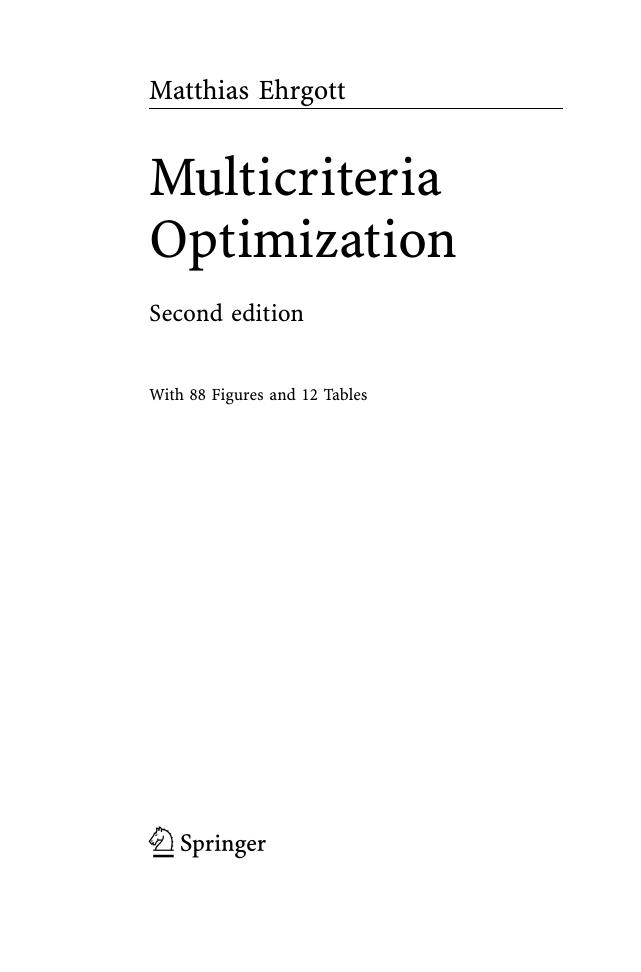
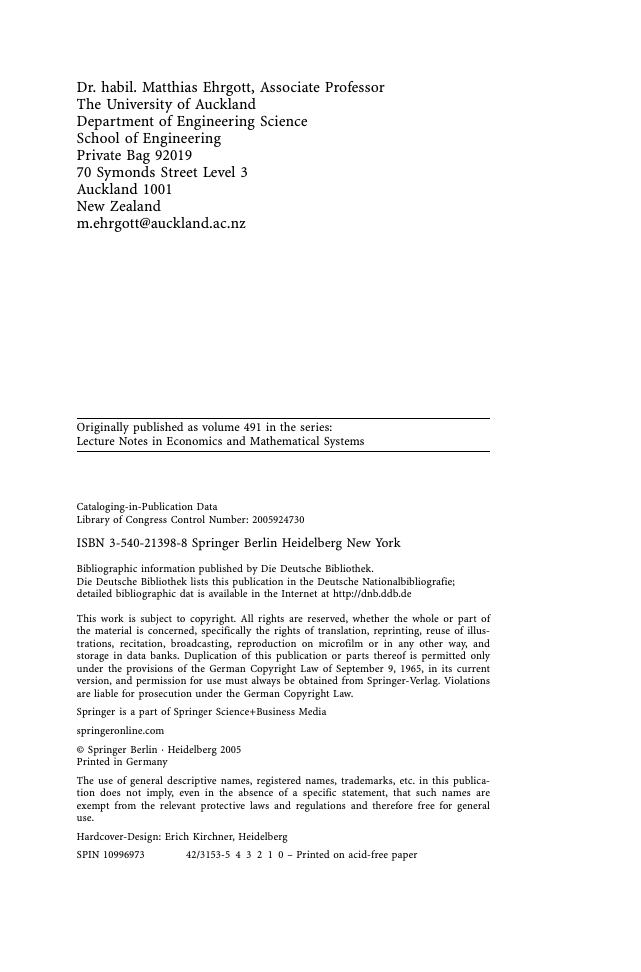

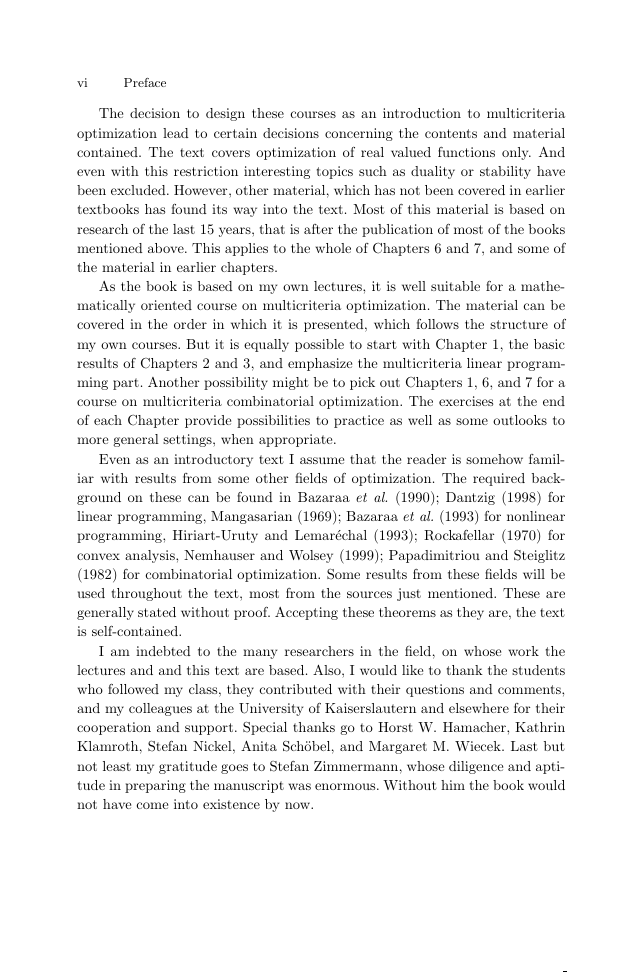
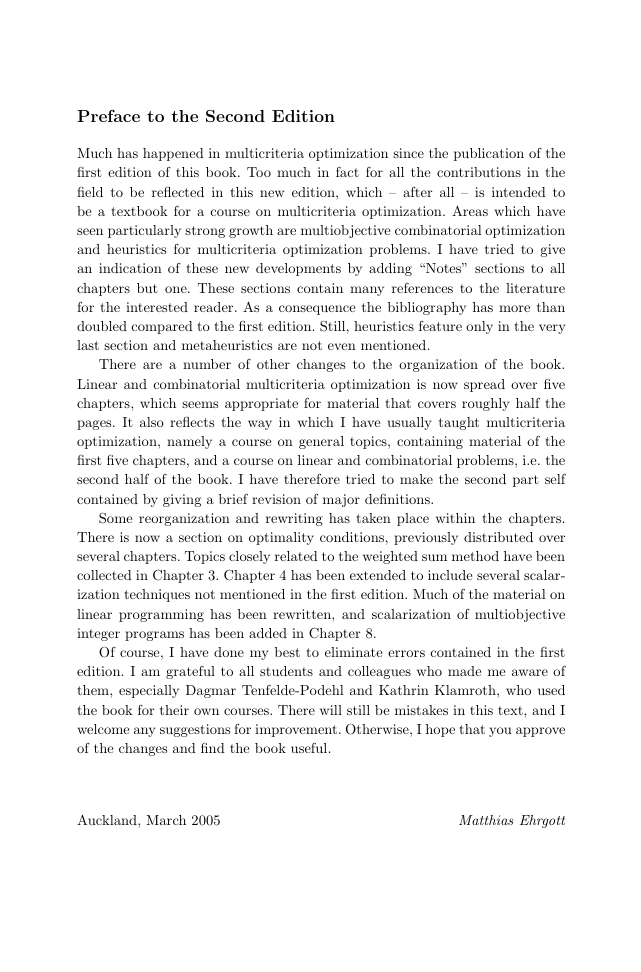
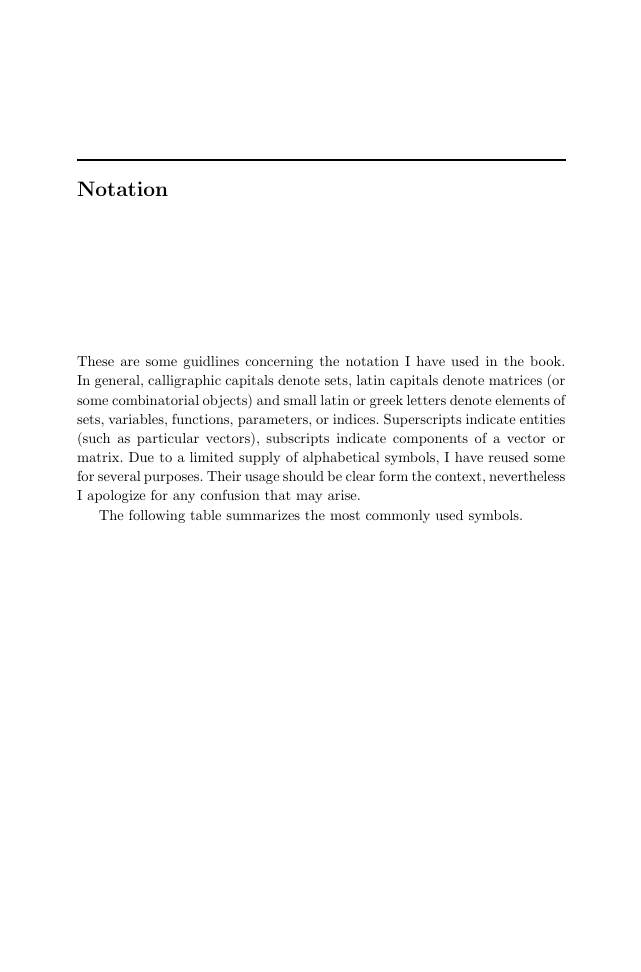
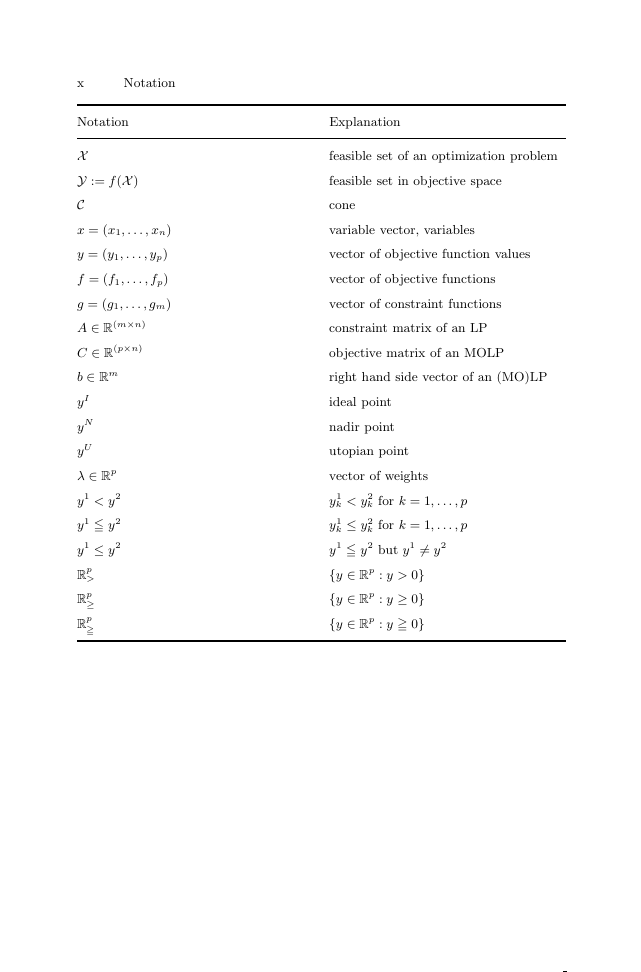








 2023年江西萍乡中考道德与法治真题及答案.doc
2023年江西萍乡中考道德与法治真题及答案.doc 2012年重庆南川中考生物真题及答案.doc
2012年重庆南川中考生物真题及答案.doc 2013年江西师范大学地理学综合及文艺理论基础考研真题.doc
2013年江西师范大学地理学综合及文艺理论基础考研真题.doc 2020年四川甘孜小升初语文真题及答案I卷.doc
2020年四川甘孜小升初语文真题及答案I卷.doc 2020年注册岩土工程师专业基础考试真题及答案.doc
2020年注册岩土工程师专业基础考试真题及答案.doc 2023-2024学年福建省厦门市九年级上学期数学月考试题及答案.doc
2023-2024学年福建省厦门市九年级上学期数学月考试题及答案.doc 2021-2022学年辽宁省沈阳市大东区九年级上学期语文期末试题及答案.doc
2021-2022学年辽宁省沈阳市大东区九年级上学期语文期末试题及答案.doc 2022-2023学年北京东城区初三第一学期物理期末试卷及答案.doc
2022-2023学年北京东城区初三第一学期物理期末试卷及答案.doc 2018上半年江西教师资格初中地理学科知识与教学能力真题及答案.doc
2018上半年江西教师资格初中地理学科知识与教学能力真题及答案.doc 2012年河北国家公务员申论考试真题及答案-省级.doc
2012年河北国家公务员申论考试真题及答案-省级.doc 2020-2021学年江苏省扬州市江都区邵樊片九年级上学期数学第一次质量检测试题及答案.doc
2020-2021学年江苏省扬州市江都区邵樊片九年级上学期数学第一次质量检测试题及答案.doc 2022下半年黑龙江教师资格证中学综合素质真题及答案.doc
2022下半年黑龙江教师资格证中学综合素质真题及答案.doc